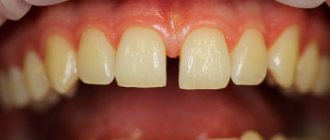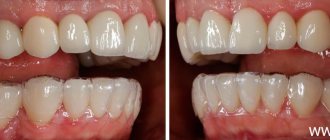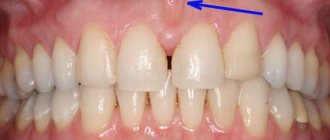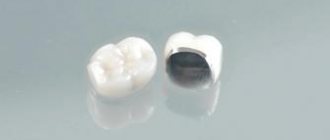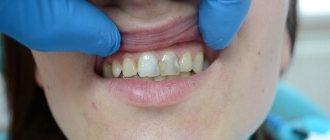What is the name of the gap between the teeth?
The scientific name for the gap between the upper front incisors is diastema. Dentists divide diastemas into true and false. The latter are temporary large gaps in children and adolescents, which appear due to too early loss of baby teeth, an incompletely formed bite and some other orthodontic phenomena, but disappear naturally over time. True diastemas in children and adults are gaps between the front teeth, which are corrected only after certain treatment.
As for the enlarged spaces between the lateral teeth, they are called trema; they arise due to the beginnings of “extra” teeth and other disturbances during the formation of the bite. Tremas can also appear after the loss or removal of one or more teeth, when the remaining teeth “diverge”, taking up the vacant space.
Types of diastemas
Diastema can be false or true:
- False is typical for children during the period of change from a temporary bite to a permanent one. In other words, it can occur in a child whose baby teeth have not yet been replaced.
- The situation is different with true diastema. It appears in adulthood and can have different forms, in particular, asymmetrical or symmetrical. This anomaly does not disappear on its own; it can only be removed with the help of qualified dentists.
Why did gaps appear between teeth?
In childhood, a gap between the front teeth most often appears when the frenulum of the upper lip is attached too low - almost between the teeth. This applies to the front teeth. Another common reason why gaps appear between a child’s teeth is the buds of “extra” teeth that form in the jaw bone and prevent the teeth from closing together. However, very often a large gap between the teeth, both front and side, in children and even adolescents is a temporary phenomenon and disappears on its own when the bite is finally formed.
At the same time, in many cases, the gap remains in adulthood, if it is not very large and the rest of the smile is proportional, it is even considered a kind of highlight.
Treatment
Correcting gaps between teeth in children often requires the participation of not only an orthodontist, but also dentists of other specializations: therapists, surgeons, orthopedists and periodontists.
After eliminating the cause, the incisors are shifted to the center. In childhood, this can be done with the help of:
- orthodontic devices with wire spring arms;
- bracket systems;
- elastic mouth guards
The sooner parents seek help, the sooner and at less cost a positive result will be achieved. Experts emphasize that regular observation by a dentist is a guarantee of the harmonious development of the dental system.
The Shifa clinic provides all types of services to restore the aesthetics of the dentition. Our specialists regularly improve their professionalism in Russia and abroad, and are familiar with the latest achievements in the field of dentistry. And computer modeling, which is widely practiced at the Shifa clinic, allows us to assess its prognosis even before the start of treatment and draw up an optimal correction scheme.
What does a gap between teeth mean?
As we have already said, large gaps between the teeth may mean that there are rudiments of “extra” teeth in the jaw bone. This phenomenon can be easily determined using an x-ray; it can also reveal another reason for the formation of a gap between the front incisors - an overdeveloped bone septum. But most often, diastemas arise from a low-attached frenulum of the upper lip. In many cases, eliminating gaps between teeth corrects not only the aesthetics of the smile, but also functional problems - speech defects caused by diastema, malocclusion and others. In addition, quite often people who are critical of their appearance consider their gaps between their teeth to be an obvious defect, which leads to decreased self-esteem and psychological problems. In any case, diastemas and trema are treatable. At your request, the doctor will always be able to remove the gap between the front teeth, even if your case is not critical and does not threaten health problems.
Is it necessary to remove a gap between teeth? The dentist answers
The space between the upper central incisors is called a “diastema,” and the gaps between the remaining teeth are called “trema.” Parents of children who have this feature regularly ask themselves: should something be done?
Yulia Selyutina
Dentist
We asked the founder of the Dentistry Center, Yulia Selyutina (@stomatolog_selyutina), to tell us until what age is this normal for a child, and at what point should you still seek help from a specialist.
What causes diastema to appear?
Diastema can develop for several reasons. Here are the most common:
Low-set frenulum of the upper lip (this is a strand of mucous membrane that you can see in a child by lifting the upper lip);
The presence of an additional tooth bud between the roots of the front teeth (rare);
Massive bony septum between the upper central incisors;
Abnormal shape of the upper incisors (microdentia).
The child has a diastema. At what age should you seek the help of an orthodontist and what will be the treatment?
In a primary dentition, a diastema usually does not require external intervention and after changing to a permanent one, it may not appear again.
But if, nevertheless, a “gap” remains between the permanent teeth, then you need to contact an orthodontist.
Surgical repair of an overdeveloped or low-attached frenulum of the upper lip (so-called “short frenulum of the upper lip”) eliminates the common cause of diastema.
Upper lip frenuloplasty is not performed until all four anterior incisors have been replaced. Until the permanent incisors have completely erupted, using frenuloplasty, you can correct their position and prevent the teeth from moving apart, forming a diastema. The plastic surgery procedure is simple and is performed under local anesthesia.
But the gap itself may remain. Therefore, an integrated approach and treatment by an orthodontist is needed. Cosmetic techniques are often used to eliminate the gap, such as installing veneers or tooth augmentation to bridge the “gap.”
What happens if the diastema is not eliminated?
If nothing is done about the diastema, it can lead to gum disease, the formation of “pockets” in the periosteum, and premature tooth loss. Due to the diastema, incorrect pronunciation of hissing and whistling sounds may occur.
What if there are large gaps between the remaining teeth?
The spaces between the remaining teeth are called “tremes”. They come in several types.
False Tremes
They appear during the period of change of baby teeth, are absent in the permanent dentition, it is because of them that parents most often worry and run to the doctor. It definitely won’t be superfluous; it’s better to consult a doctor than to come in a bad situation where you’ll spend a lot of nerves and money.
The appearance of false teeth is a physiological feature of the dentition. They appear between four and five years of age. The child is actively growing, and so are his jaws. But the baby teeth remain the same in size and seem to “diverge” in the dentition, forming just three teeth. There is no need to panic, this is an absolutely normal situation.
Permanent teeth are larger than baby teeth and need space in the jaw. But if at this age the child does not develop gaps, and the baby teeth are in close contact with each other, then this is worth paying attention to and visiting a doctor. There may simply not be enough space for permanent teeth and a deficiency will form.
True trems
After complete replacement of milk teeth with permanent ones (there are no extracted teeth). True tremors cannot be treated, as they occur during the period of teeth change. They develop as a result of active growth of the jaws.
Pathological trema
They occur when a permanent bite has already been formed due to gum disease or bone atrophy. It is necessary to look for the exact cause: tilting of the teeth (protrusion), massive frenulum, short frenulum, early tooth extraction, congenital anomaly of tooth shape (microdentia - when the tooth is narrower than it should be, and there is too much space in the jaw) or an abnormality in jaw size, periodontal disease (i.e. bone atrophy and root exposure).
To identify the cause, you need to contact an orthodontist. If the problem is a discrepancy in the size of the teeth, then an orthopedist is involved. A restoration is performed or a veneer/crown is placed (that is, an artificial increase in the size of the tooth is carried out). If there is a problem with periodontal disease, then you need to look for the problem and eliminate it. An accompanying bad habit that aggravates the course of periodontal pathology is smoking.
Do not forget about the importance of regular medical examinations of your child at the dentist: do not skip them and observe with your doctor the formation of both primary and permanent dentition in order to avoid problems with the bite and health of the entire oral cavity in the future.
Read more on the topic
The child's baby teeth are not growing. This is fine?
The child grinds his teeth in his sleep. And during the day too! What to do about it?
Human anatomy in cotton swabs and balls: 8 interesting crafts
Who are we and where can you read us?
After all, we have not only a website!
How to remove a gap between teeth?
If you are unhappy with the gap between your front teeth or want to get rid of three, consult a dentist. At the first appointment, he will determine the reason why you have a gap between your front teeth or gaps between your side teeth, and will draw up a treatment plan. An x-ray or orthopantomogram may be required. Next, the doctor decides how to correct the gaps between the teeth in a particular case.
If the cause of the diastema is the frenulum of the upper lip, then correcting the gap between the teeth will require plastic surgery of the frenulum and minor orthodontic treatment. Trimming the frenulum in modern dentistry is performed bloodlessly and painlessly using a laser, and braces will help “move” the teeth. If you are concerned about your appearance during treatment, the orthodontist will advise you to use lingual braces - they are attached to the back surface of the teeth and are completely invisible. Sometimes you can do without braces at all; in such cases, transparent aligners are used.
If the gap is formed due to an overdeveloped bone septum, the intervention of an oral and maxillofacial surgeon may be required. But, as a rule, the problem of the gap between the front incisors can be solved very quickly by replacing the front teeth with ultra-modern restorations, for example, composite veneers.
Reasons for the anomaly
A large distance between the front teeth can appear due to various factors:
- too small teeth with a large jaw volume;
- intrauterine disorders during the formation of the dentition;
- a large frenulum that connects the inner surface of the lip and gum;
- formation of an incorrect swallowing reflex (if during swallowing the tongue rests on the front teeth);
- bad habits that develop in childhood (prolonged use of pacifiers, bottles and other means);
- periodontal diseases, as a result of which the volume of bone tissue decreases;
- incomplete use of the braces system, when teeth move apart due to failure of the retention period;
- functional changes in children during the formation of temporary occlusion.
Photos of stars with a gap between their teeth
Many stars not only do not seek to correct the gap between their teeth, but also insist that this is their distinctive feature, such as Lily Aldridge, who forbids photographers to “Photoshop” her smile. Dentists have different opinions on this matter: some consider the gap between the teeth a defect and insist on correcting it, others believe that if the increased gap between the teeth does not interfere with its owner’s life, then it is not worth touching it and once again injuring the oral cavity.
Cher Lloyd
A popular participant in the English release of the cult show X Factor chose to get rid of the gap between her teeth using aesthetic teeth extensions and, I must admit, she made the right choice.
Zac Efron
The reason why Zac Efron decided to fix the gap between his front teeth is clear. Shcherbinka gave him a too immature look, while the actor dreamed of serious roles in films. And in order for dreams to come true, you have to sacrifice something.
Madonna
Madonna has never had any serious problems with her teeth, except for a small gap. But over the years, she still needed the help of an esthetician dentist. Madonna had the shape and color of her teeth corrected, but the gap between her teeth remained, which looks very natural and does not spoil her at all.
Diagnosis of diastema
Often the diastema is too noticeable to the naked eye - when smiling, it looks like a black triangle between the front central teeth . Diagnosis of diastema is accompanied by identifying the causes of the anomaly . The development of the disease can be noticed by the patient himself, revealing an increase in the gap between the teeth when brushing or flossing. Additionally, strengthening of the diastema will be detected by the dentist during regular examination.
During diagnosis, the most optimal treatment method is selected for each specific case, so that such treatment can best meet the needs of individual patients.
When and how is it necessary to correct the sagittal gap?
Correction of a sagittal gap of more than 2 mm in children is traditionally performed at the age of 11-13 years. It is during this time that adolescent jaw growth peaks, and orthodontic correction will be extremely effective.
The task of parents and doctors is to quickly eliminate the factors that cause it. We can influence bad habits and normalize nasal breathing. The set of measures may include, if necessary: 1. Consultation and treatment with an ENT doctor 2. Search for the causes of the bad habit and their elimination (consultation with a psychologist often helps to understand the cause and eliminate the habit) 3. Help from a speech therapist in normalizing the position of the tongue 4. If the gap is more than 6 mm, it is necessary to start orthodontic treatment as early as possible (5-6 years is already an appropriate age).
At an early age, orthodontic correction will not be aimed at treating malocclusion, but at correcting the sagittal gap and reducing the risk of injury to the child’s front teeth.
Correction of the bite, if necessary, will be carried out later - at the age of 11-13 years, when the child experiences a growth spurt in the jaws. During this period, you can effectively influence the growth of the lower jaw if it is small.
Why does a large sagittal fissure form?
An increase in the distance between the incisors of the upper and lower jaw can be formed under different conditions: 1. A large upper jaw, which does not correspond to the lower jaw (macrognathia of the upper jaw) 2. A small lower jaw - does not correspond to the size of the upper one (micrognathia of the lower jaw) 3. The upper incisors are too pronounced forward tilt (the so-called protrusion of the incisors) 4. A combination of the above
The most common causes of the formation of a sagittal fissure 1. Impaired nasal breathing (adenoids, allergic rhinitis, etc.) 2. Serious injuries to the maxillofacial area 3. Bad habits (finger sucking, pacifiers in children over 1.5-2 years old, biting the lower lip etc.) 4. Hereditary factor, developmental defects
What is a diastema?
Diastema between teeth is a common and very controversial disease in dentistry. There was a time when no treatment was carried out to normalize the position of the teeth. But doctors came to the conclusion that treatment is necessary, since speech function is impaired, and psychological difficulties arise due to aesthetic defects.
Diastema can be true or false:
- True occurs when the bite is formed.
- False occurs when changing teeth - does not require treatment and goes away on its own.
There are also symmetrical and asymmetrical diastemas depending on the position of the teeth.
What are the differences between diastema and trema
People often unknowingly confuse these concepts. The differences lie in the position of the interdental spaces. In the first case, we are talking about a gap only in a “unit” (the reason for the appearance of gaps between the front teeth in adults and children will be discussed below), located on the upper or lower jaw. Sometimes the distance reaches a centimeter, but more often there are gaps of 2-5 mm. The problem is diagnosed in 50% of preschool children with temporary dentition and in approximately men and women with permanent dentition.
Another type of chip is found in different areas of both rows, but not in the center. The location of the defect depends on the factors that provoked its formation.
Artistic restoration
If the space between the front teeth is small, it can be removed using a cosmetic restoration with a regular filling. To do this, the dentist will make a small filling between the incisors. This method of treating gaps between the front teeth has several advantages:
Defect resolution speed. You can get rid of an unsightly gap between your front teeth by visiting a dentist;
Low price. The cost of eliminating a gap between teeth with a filling will be 3-4 thousand rubles.
But this method of eliminating the gap between the front teeth has its drawbacks. The filling may change color, break, and its installation increases the risk of caries in the joint between the teeth.
The artistic restoration process also uses composite filling materials to fill gaps between teeth. But the dentist will apply them in a special way - in layers. This technology allows you to obtain the most aesthetic and long-lasting restoration results (compared to conventional fillings).
Removing gaps between teeth using artistic restoration is more expensive than installing a conventional filling.
If you have eliminated the space between your front teeth using artistic restoration and want the positive results to last for a long time, try to reduce the load on the front teeth. To do this, do not gnaw with your incisors, and especially do not try to gnaw something hard with them: nuts, seeds.

